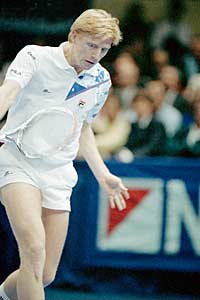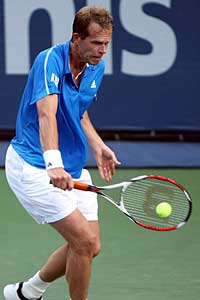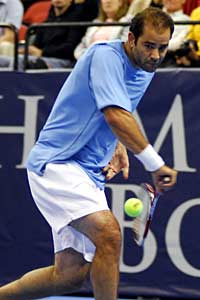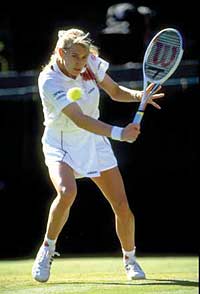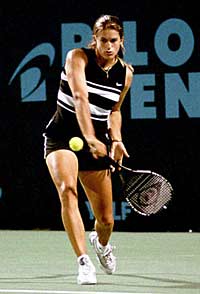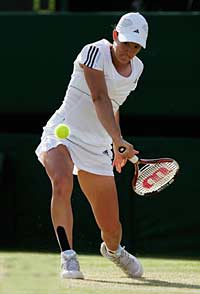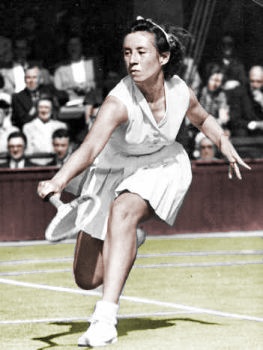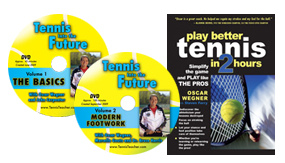|
TennisOne Lessons Backhand – One Hand or Two?The Realities of Two Contrasting Backhand StylesOscar Wegner Today there is a tendency to teach a two-handed backhand when coaching youngsters of high level. A quick observation shows that most of the young players we see at important competitions are, in fact, two-handers. The exception is the defensive reach for a distant ball where a one-handed slice is the tool of last resort, or a slower ball to change the pace of the rally.
On the men’s tour, we see four one-handed backhands in the top 20. On the women’s side, the odds of being two-handed on the backhand are even more dramatic. Only one top 20 player, Francesca Schiavone, plays the backhand one-handed. We could also include a returning Justine Henin in this category, to make the scenario less one-sided. Is the two-hander a more formidable weapon, or is something else behind this particular trend? Recent History Keeping in mind that the equipment started to change in the 1980s, and that the larger-size graphite/composite material established itself on the tour in the early 1990s, it would be fair to include in this study only players of the last two decades. On the men’s side, including the last 80 weeks of former reigning number one Ivan Lendl, which ended in August, 1990, and including Boris Becker, Stefan Edberg, Thomas Muster, Patrick Rafter, Pete Sampras, Gustavo Kuerten and Roger Federer, one-handed backhand players had 688 weeks at number one out of a total of 1,047 weeks, that is, close to 66% of the time.
Two-handed backhand players, including Jim Courier, Marcelo Ríos, Carlos Moya, Yevgeny Kafelnikov, Marat Safin, Lleyton Hewitt, Andre Agassi, Juan Carlos Ferrero and Andy Roddick, spent 329 weeks at the top of the world ranking, about 34% of the time. On the ladies side the success of two-handers is more dramatic. Only Steffi Graff, Justine Henin and Amelie Mauresmo have been number one in the world with one-handed backhands. Starting with Steffi Graff’s record reign for 186 consecutive weeks, these three women were number one for 533 out of 1,056 weeks, roughly 50% of the time. If you factor in that the reigning number one woman in 1993, Monica Seles, was sidelined from a stabbing incident after being at the top for 86 consecutive weeks, the numbers favor slightly the two-handers, eleven in all, including Arantxa Sánchez Vicario, Martina Hingis, Lindsay Davenport, Jennifer Capriati, Venus Williams, Serena Williams, Kim Clijsters, Maria Sharapova, Ana Ivanovic, Jelena Jankovic and Dinara Safina.
Why the trend to Two hands? As you may have noticed, most of the top pros today have started playing tennis assiduously before they were 10 years old; many before they were 8, and some before they were 6 years old. At a tender age the two-hander is a solution for lack of power in the shoulder and upper back. Most efforts by a child in everyday early life consist of picking up light things and lifting them, developing the strength of the front muscles most. On the forehand, if left on their own, tiny tots tend to use two hands to hit it, especially if the racquet is of some size. The same for the backhand, but here for a more specific reason: it is much easier at that stage. Some, copying an adult or some favorite player on TV (today’s prevalent baby-sitter), may have a mental image or decision to be a one-hander in the future. But for starters, they choose the easier course. As their physical development progresses, so does their strength. If the child is already a good player and is becoming what is known as a kid-phenomenon, hitting every ball back in the court, parents and coaches take notice and they aid the youngster providing as much practice time as possible. This reinforces the child’s muscle memory and confidence that what he or she is doing is the correct way to advance the goal (a goal the parent and coach may share as well). The young player could be faced with making a decision as to whether he should keep the two-hander as a main backhand stroke, or switch to a one-hander. The one-handed slice is introduced usually as a supplementary, defensive stroke. But it is not unusual for parents or coaches to have some ideas of their own, insisting the player switch permanently to a one-handed stroke. The player may be wary of taking that route. What would be your response if you have money in the bank and you are offered a proposition to use it all in a new investment, one which would take some time to produce results? Would you give up your security in an instant, deciding to struggle for a couple of years until your investment paid off? Or would you be more conservative and keep something that obviously is working and giving you results?
One new factor that may facilitate a decision as a child begins in the sport is the emergence of progressive tennis, where strength is not a factor, even for the tiniest of tots, because of the use of appropriate size equipment, i.e. small, light racquets and soft, low pressure, low bouncing balls. Today’s appropriate child equipment makes the coach’s decision far easier. What type of player does he prefer? A dogged two-handed groundstroker like Nadal, with limited incursion to the net, or an attacking wizard like Pete Sampras, who traded his trusted two-handed backhand for the unknown vagaries of the one-hander in his early teens. Sampras had his role model, Rod Laver, in sight for his choice. The kid in the video, Jan Silva, a child phenomenon before he was four years old, had James Blake in mind, watching his recordings over and over before he learned to walk. Advantages and Disadvantages We all know the advantages and disadvantages associated with each of these strokes, like the added reach of the one-hander or the shorter backswing on the service return of the two-hander, however, these things are incidental, because champions come in both styles. So, how does one arrive at a decision? Is it best left to the coach or the parent who takes the child to the court for the first time? Would that bring the full potential later in the child’s life?
That brings another interesting point. Many human beings are one sided, meaning they have a preference to do things with one particular hand, others are ambidextrous. Furthermore, some are left-handers confused by the social trend insistence that they use primarily their right hand. According to science, the left brain is predominant for right-handers, the right-brain for the lefties, for some others they work in cooperation, for still others, the left and right fight. Furthermore, in my experience as a tennis coach, in many cases the authoritarianism of the adult, whether a parent or a coach, over the child leads to a confusion that determines whether the child (or the grown adult) is coordinated or not. On the other hand, on the advice of their coaches, champions like Maureen Connolly and Rafael Nadal, a left-hander and right-hander respectively, learned to play tennis with their off hands. So, how should such a plethora of options, right-hander, left-hander, two-hander, backcourt wiz or attacking whiz, be handled? Easy solution, show the child his options and let him choose that which feels most natural. If he changes his mind after a while or after a few years, let him. After all, it is his game and his life. The toddler does not speak yet? Play games where he might develop ability in both hands, and he’ll let you know his preference. You can do the same when you start him on the court. Show him everything, but let him be the boss. Bear in mind, as well, that two-handers can develop exquisite deft with one hand on defensive shots or as a change of pace as did Mats Wilander late in his career. It is easier for a budding player to decide early in his career which route to take if he has already envisioned himself as emulating the strokes of his favorite tennis star. He’ll either prefer to be one-handed across the board, or half-and-half. But the decision is complicated with the existence of a team; everyone may have an opinion of what the next step should be. From my experience, the decision is best left to the child, with a short trial of the options, which will preserve his love of the game. I allow my students to make up their minds, and even change their minds. Tennis is a game, and on court, it is best played by the player, not by his team in the stands.
Decisions like this must be made carefully. By imposing a change, the team may be unwittingly fighting against something that has become instinctive and has been chosen intuitively by the player as the best way to perform. On the women's side, the choice is complicated by the prejudiced idea that girls lack strength to hit one-handed backhands forcefully. Although it is true that little boys tend to lift heavier weights earlier in life than little girls and it is in the culture and in their childhood games, girls don’t have to be restricted to the two-handed backhand. This idea that girls can't hit one-handers is easily contradicted by the fact that the best one-hander in women's tennis was Justine Henin, one of the smaller girls on the tour. So, this misconception of girl’s strength is easily conquered with the proper practice. Girls can have great strength in their upper body with adequate muscle conditioning. Now comes the million dollar question: which is the superior stroke, the one-handed backhand or the two? The answer is neither, it depends on the person. Champions come in many different packages. People have different assets and different strengths. Some are ambidextrous, some are one sided, some don’t express a preference. The most practical route would be to ask the young player if he wants to give both backhands a try. Test it for as long as the player wants, including alternating both styles so he can make an informed choice. It is interesting to note that the subject of backhand preference applies to adult beginners as well. Decision is king. It is far better for the player to make an informed decision (meaning trials of right and wrong) than a shot in the dark. In the case of sports, feeling strong and natural is perhaps closer to the spirit. Let feel be King. Your comments are welcome. Let us know what you think about Oscar Wegner's article by emailing us here at TennisOne .
Oscar Wegner
Richard Williams first saw Oscar Wegner teaching on The Tennis Television Show. Richard was so convinced that this was the right way to teach, that he trained Venus and Serena solidly with this system. Four years later, incredibly for those not familiar with these techniques, the sisters made a smashing start on the pro tour. In 1999 he personally acknowledged and thanked Oscar for his astounding methodology. Oscar continues to produce groundbreaking instructional DVD and helping coaches around the world to modernize their teaching style. For more information about Oscar Wegner's teaching methods, visit Oscar's site at tennisteacher.com |
